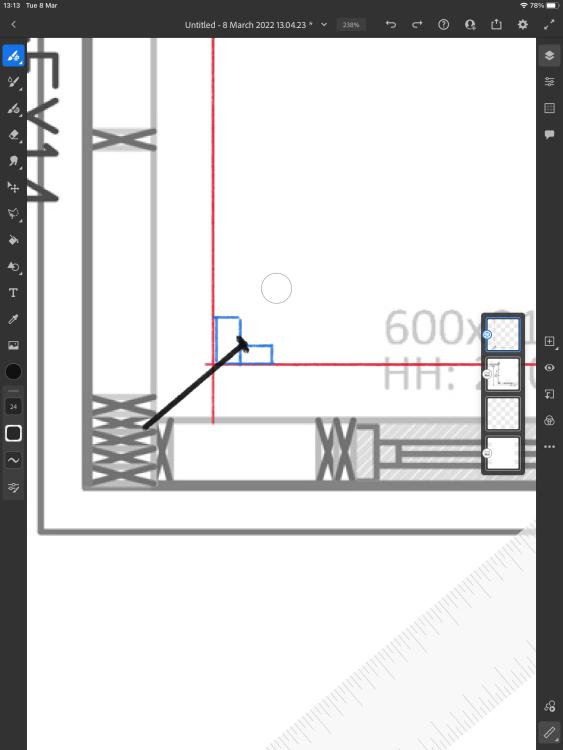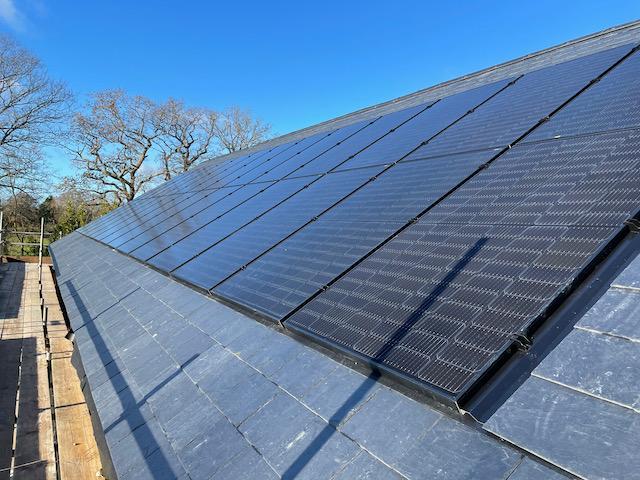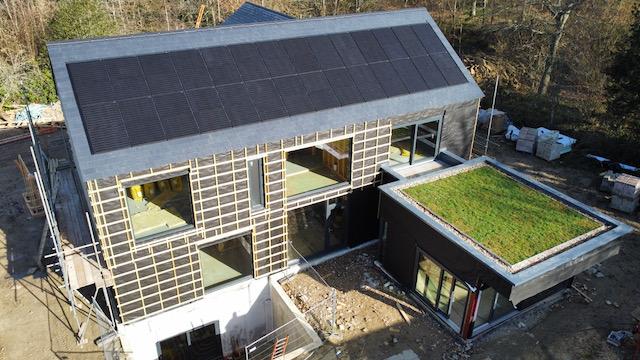Leaderboard
Popular Content
Showing content with the highest reputation on 03/08/22 in all areas
-
Will be OK. Make sure to plasterboard the shorter side first.2 points
-
Sort of like your first thoughts. But I would get two battens and screw them together to make a corner piece, then offer this up into the corner and screw through on an angle.2 points
-
Have a search on here or just read the Timber Frame forum thoroughly and you’ll soon get an idea of who people used. MBC are good at what they do in offering guaranteed air tightness results and foundations as a package but they’re not the cheapest by a long stretch. we decided to get an open panel TF (from Flight Timber) and fit the insulation and airtight membrane ourselves. This saved a LOT of money but has taken (and we’re still at it) a LOT of time. every one’s situation is different and you need to figure out what is best for you.2 points
-
I suppose it's a question of terminology. Some folk think that sistering means doubling up the joists and connecting the two together along their length so you create a joist twice the thickness of the original one out of two bits of timber coupled (bolted say) together (the old and the new).. thus roughly you can double the load without a bad outcome. But remember that the old timber will have creeped a bit and seasoned so will probably pick up a bit more load first before the new "bendy" timber starts to pull it's weight. Something to consider if you have a period ceiling below. Or sistering can maybe interpreted as adding another joist in between the existing? making it a bit higher and thus you create a floating floor..have done this where you really decouple the new floor / attic loads from a ceiling that is sensitive, say an ornate ceiling. There is quite a lot to think about when doing loft conversions. Often you don't want to mess with the floor / ceiling below as you are living there. Now a plasterboard ceiling often has dwangs / noggins so to sister (doubling up) you need to cut them, to get your new timbers in at the same depth as the existing joists.. and refix the dwangs / noggins. A bit of a guddle (faffing about) = £cost. Often you find that there are cables, a few pipes etc and to keep the cost down it's helpful not to have to move them, especially over the consumer board area if a lot of cables run up into the loft. A lathe and plaster ceiling relies a lot on the plaster squeezing up between the lathes and expanding (belling out) to create a mechanical key. Call these the snotters. Would be interested to hear what the local term is in different parts of the UK. If you knock them off then the plaster will become loose , particularly as the timber lathes will have shrunk over time. Often it's best to have a look at what you have early on; can you move out, do you have period features etc and then see how you do it structurally to accommodate the constriants.2 points
-
Gravity is very good at holding things in place and we don’t really have earthquakes1 point
-
There are standard payments set but I don't know where to find them. We have a number of poles carrying a 33kv oh power line and we get a set amount per pole per year. It's basically chicken feed and given the choice I would undoubtedly try to avoid having any kit on land I owned. I doubt the DNO wants loads of bespoke agreements with different people. That said there may be leeway if you effectively own a ransom type strip. It's a complicated subject area and I can't claim to be highly knowledgeable about it. One thing I would mention is that when we were negotiating the wayleave with SSEN (it was an existing line with no wayleave when we bought the land) they were obliged to cover our costs for obtaining professional advice so we didn't get shafted. We were free to choose who we wanted to do this. If you do end up in discussion it would be worth considering this.1 point
-
The big cost saving would be to stick build the house. I decided to go for a stick build kit for our self build, a few years ago (2018-19), prices have of course risen since then and our house is smaller at 138m2, then the design in the link. It cost £13k for the materials to build the kit. Included within that is £5k for engineered attic trusses from Pasquill. Labour was £9k, for making the kit, erecting it and also a suspended ground floor. Other expensive items were a steel beam for the vaulted ceiling and three Kerto beams for the middle ridge part. I also had to hire a telehandler with a truss jib for two weeks that cost around £750. By the end of that we looked like this (excluding the velux windows).1 point
-
In the section referencing CTs, the doc says "Typically, all interface functions are contained within an Inverter and in such cases it is only necessary to have the Inverter Fully Type Tested". I read that as if youre using a G98 inverter any CT or CT function providing interface protection is integral to the inverter. There may be a need for a CT to manage battery charging but thats on the DC side and not part of the export limitation that the DNO is interested in. Id speak to the inverter manufacturer and clarify things with them.1 point
-
While the concept sounds ok I assume the code you write will include all the "what if" failure conditions that you may know about and the ones you don't. Via cable the inverter gets a continuous signal. MQTT will not give you that even at very high sample rates. I run MQTT on a Pi3 and while ok there has been the odd delay or sticking over the last three years and even needing two reboots even though it's on a UPS. For some "on and off" switching activities I have included tripple switching just to make sure in cases where there is not instant feedback. I also ping the various modules to see if they are alive and have a fallback or restart process if not. ...not that you can do it anyway...1 point
-
Pity the professional estimator, who does it all day, every day, and gets criticised for winning a job too cheap, or for losing the work. I was that man.1 point
-
We're just about to start construction on our self build. It's main builder led so am not doing anything ourselves. If anyone is after any prices for things (roofs, joinery, ASHP, windows, doors, aluminium sliders, garage etc) let me know as I found pricing up one of the hardest things when starting out. I ended up being miles out! Build is in Lancashire, traditional brick and block, blown insulation, traditional roof.1 point
-
For the cost of an IC, depending on depth I would install one anyway as a demarcation chamber.1 point
-
Short term / medium term / long term. Long term - yes, sure, let's all have passive houses with great cheap storage and PV or whatever will be the latest tech in 30 years. Short term - we can't insulate 10mil properties to a high standard quickly and doing it badly seems to be a waste of resources. So solve the problem of energy dependency short term, then move on to the medium term tasks. Green energy is not a short or a medium term solution, this is my point.1 point
-
That doesnt sound right to me. AFAIK if the PV and battery sit on the DC side of the inverter and you use a G98 compliant inverter then the DNO isnt interested in how anything else works ie how your CT connects to the inverter/battery charger. The DNO may insist on a wired CT(or anything else) if its being used for G100 export limitation but with a DC coupled G98 inverter an export limitation system shouldnt be needed1 point
-
Surely the best way to reduce dependence on Russian (or other unfavourable regimes) oil and gas is to reduce the overall energy requirement, as well as invest in zero carbon alternatives? The majority of UK houses are still hopelessly energy inefficient. I realise that I'm lucky to be in a self built passive house and as such have relatively low energy requirements for heating etc but we must improve the fabric of the nation. I expect that one upside of the painful increase in utility prices will be more careful usage and thought on how to reduce domestic bills permanently.1 point
-
1 point
-
Another vote for pre-making the corners and fixing at an angle. 200mm screws will give the correct fixing, with 50mm embedment into the studs. Again, pre-drill everything.1 point
-
So essentially you are trying to screw diagonally through a batten into the corner of the stud. If you use some really sharp screws that screwfix sell that shouldn't be a problem. Can be hard predrilling the batten on the diagonal. Id either bash the corner with a hammer to make a flat point for the drill or i suppose run them through the table saw to cut a corner off. Then your drill starts easily on the flat surface.1 point
-
In its simplest terms an EV charger is logic controller switching a contactor, that is is. Yes you get OCPP control stuff with GSM etc. however, as a home owner, paying your own bill you don't need any of this. Within the charge cable is a data pair and the mains. The car tells the logic controller it wants charged and it turns on the contactor, the cable goes live. Simple as that. A friend has a VW ID with a home made charger, he could have got a £350 grant towards it, and the installed cost was about £1100 - he built one for about £250 in a nice stainless steel enclosure. Google EVSE charge controller, they can be had on eBay, Amazon and more reputable EV equipment outlets like Stegen, some have LCD screens incorporated, some remote so you can panel mount it and some have nothing depends what you want. I just want something to switch a relay on and off.1 point
-
1 point
-
Well, you first need to persuade the insurer (or broker) to accept a CC payment - they may refuse due to the associated card processing fees for such an expensive policy. Secondly you may only be covered if the policy never goes 'on risk' i.e. if the entity that you pay (likely the broker) is not able to fulfil their side of the contract. We have had a good experience in getting a card refund in the past when our balustrade firm went bust with a few items still to deliver. Once the card issuer (John Lewis via HSBC) was satisfied that they were not trading and we had an independent report of the outstanding work and cost to address, they were quick enough to pay out.1 point
-
Just visited a mate doing a loft conversation, he has used gluelam beams instead of steel, they are huge 450x150 , but there is no need to noggin out any steel to fit joists, it all nails on the sides with hangers. Looked like a lovely job.1 point
-
Similar to us. When getting the planning for our build, I also got PP for the static caravan as accommodation during the build. Initially the planners wanted to impose the condition that the caravan be removed upon completion. I contested that, saying I could remove it, and then immediately replace it under permitted development. They responded by altering the clause to "residential use of the caravan shall cease upon occupation of the house" which puts it into line with a permitted development caravan that can only be used incidental to the house. Perhaps @Pinzameld might tell us what he wants to actually use his "caravan" for?1 point
-
I had the great pleasure of showing David Elliot around my university back in 2006. He tells interesting stories about nuclear power decision making in government.1 point
-
1 point
-
1 point
-
The idea of the standard is that is give assurance that the battens have been properly graded and will be safe to use on the roof and also to walk on and maintain in the future. No BS5534 stamp, no good for roof.1 point
-
1 point
-
Nope, most are stained red or blue, some are gold coloured, but mast that are just treated do not meet the standard for a 600mm spaced truss.1 point
-
No, i would not use those as roofing battens. I would use them as internal battens for say a service void.1 point
-
Here's a good video that explains how some people lay roof tiles. Its one of a series - very informative.1 point
-
Ok, not great, could be worse. I assume you’ve got solar PV to offset the known constant electric consumption? Would be a no brainer for you as you’ll be using your excess without a doubt eg 100% self consumption would be feasible.1 point
-
Interesting question @Bitpipe we are actually in the process of changing architects. PP has taken nearly 9 months and in that time we have had the chance to watch far too many Grand Designs (!!) but we also realised that we want a modern design which considers energy efficiency more. Our current design does not. We are looking at an air source heat pump to move away from gas and contribute to complying with the new June building regs. Haven't decided on solar panels/glazing yet, but looking at changing the angles of the house. In essence, we are planning to be as energy efficient as we can afford to be (probably not Passivhaus standards). I'll take a read to see what other people are doing. Two years ago we renovated an old cottage and amongst other things to improve the house, we insulated the walls and roof with sheeps wool, celotex and taped the edges. We [obviously] noticed massive difference! We also sounded proofed the walls with our neighbours which was very effective. We did a lot of work ourselves so maybe that is where I can share our experiences!1 point
-
1 point
-
What size and span are the joists? Sistering joists with deeper ones done correctly can also decouple floor loads from the existing ceiling joists reducing or eliminating plaster cracking.1 point
-
Ha ha.. you are not supposed to tell folk that I'm an SE.. cats out the bag now.0 points
-
Yes, it take parts of randomness and chaos, drizzles them with new means of old words, then claims to be the answer.0 points



.thumb.jpg.bac90f3bbf6868cf2118d010d936c99d.jpg)













.jpeg.eb4771dfabb40bda05ca6ff7080bd013.jpeg)
